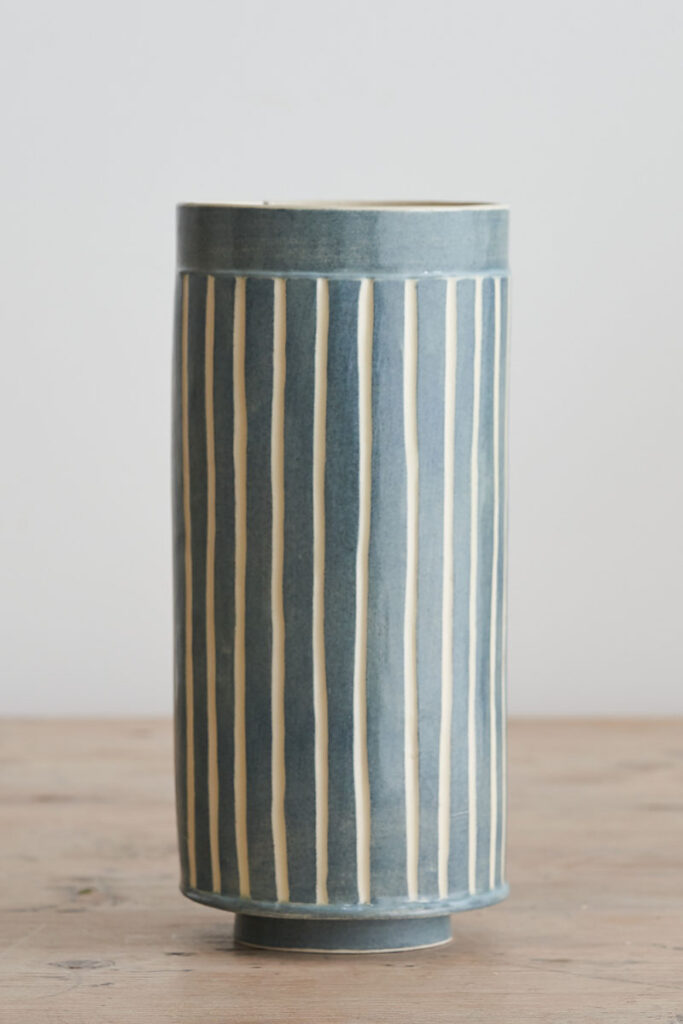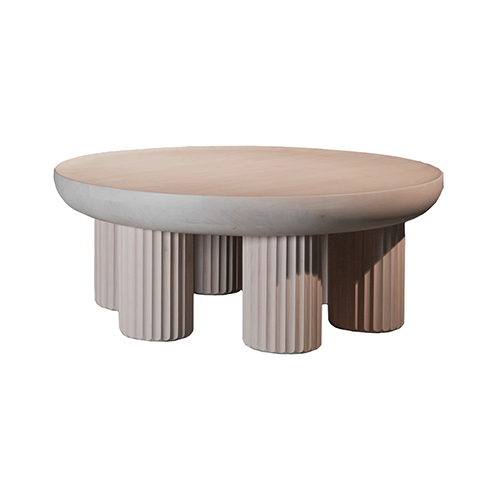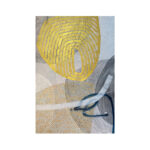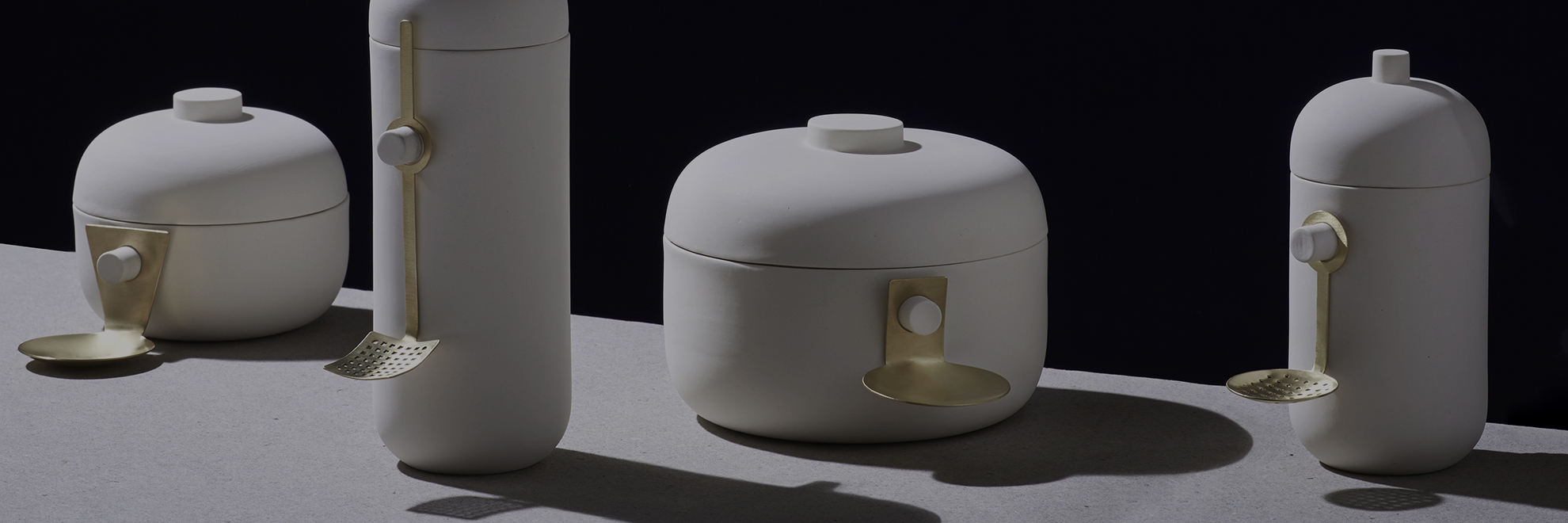Atelier Visit
Emily-Kriste Wilcox is a professional ceramicist based in Birmingham where she has her ceramic studio. She creates unique pieces hand-built, which enrich interior spaces: her four collections try to bring the inside world in to the home. Emily exhibits regularly across the UK and recently won the “Best Artisanal Interior Décor Products 2019” prize.
What satisfies you the most while working ceramics?
Each stage in my process brings its own joys and challenges – all of which encourage me to investigate further, so to pinpoint a favourite is rather difficult.
The soft clay, wedged and ready to use, is refreshing as it has a sense of positiveness that comes with starting a new piece, along with the unknown of what it will become. The stage of developing the layers of surface treatment is an intriguing one. Even though I am often using the same tones, each becomes its own painting and reflects that moment in time. The sense of intrigue is exaggerated here, as I am often painting with tones of slip which at their raw stage are varying tones of creams and pale pinks, that only become fully developed and apparent as blues/ greys after firing.
The joining and balancing stage, by its nature has sculptural qualities, which feeds the flexibility of form that hand building provides. The clay itself dictates what can be achieved at, or within a certain timeframe. Then there’s the final outcome – only after multiple firings, and the magic of the kiln’s heat can the pieces be truly seen as a whole, with their tones fully apparent.

“The flick of a paintbrush, the marks made, the tools used, and the surrounding environment all play their part”
How did you start with pottery?
I followed a course which regularly encouraged us to create pots alongside paintings – to link the two elements together throughout the projects whether that was through a particular theme or technique. This has definitely been something which I have continued to do throughout my practice so far.
I then went on to follow a ceramic specific degree course where I was introduced to lots of materials, and able to learn a number of different techniques in both construction and surface treatment. This traditional, educational route has given me a wide basis of technical skills, study and understanding before specialising and honing my own direction.
Do you have particular references when creating new works?
I regularly use a painterly approach, and each of my slab built ceramic vessels holds an abstract interpretation that can often be attributed to the landscape. Coastal colours feature regularly in the collections – with strong navy blues or muted tonal combinations of soft blues reminiscent of the sky and sea; others are slightly bolder or with a focus on greenery that may be more representative of those colours you would find across the hills or amongst the garden.
I currently have 4 collections which I have developed in order to create items that are suitable for interior décor, with an emphasis on bringing elements of the outside world into the home. These vessels can be broadly categorised into “Coastal & Lake”, “Field & Country”, “Garden & Bloom”, “Pattern & Surface”, with each one remaining individual yet with the ability to balance when grouped as a larger composition.

“Blues, greens and greys predominate the colour palette, with splashes or accents of colour to punctuate the otherwise subtle surfaces”
Can you shortly describe the process of the manufacture?
I am a specialist in hand building and over the course of almost 15 years I have developed these collections predominantly using slab building techniques, so the 3D forms all start off with a number of flat panels of clay. These are then constructed and painted with layers of decorating slips to build up the desired depth of surface. I tend to give these vessels an all over coverage of glaze for both practical and aesthetic reasons. The coloured slips are enhanced through this process with some becoming quite bold when compared to both the creamy tones when wet and the dry chalky tones that are visible at the bisque stage. I am able to build rich layered surfaces this way and create a sense of depth that results in many of the pieces holding little views to the outside world. These ‘paintings in clay’ become reminiscent of a seascape, hills cape or a reflection of the colours that you might find in the garden.
How long is the entire process usually for a product?
This can vary depending on size and complexity of surface treatment but it often falls somewhere between 3 and 6 weeks including drying times and multiple firings. For more bespoke items, commissions or large orders, pieces can take considerably longer so I endeavour to discuss each order with the client so that we can determine a suitable timeframe for the project. As each item is hand built by myself in the studio, there are often a number of projects on the go at any one time, therefore due care and attention is given to each individual one.


“Pieces often go through multiple firings and as each is individual, the process of building up the surface varies accordingly”
Colours on the finished surface is treated like art in your creations. Can you describe this aspect?
As you do paintings as well, do you find similarities between these two mediums?
I do refer to the ceramic vessels as ‘paintings in clay’ as I have developed a painterly style of working with the decorating slips in particular. Using a variation of brush alongside a variation of pigment consistency, the surfaces of clay are treated to layers of colour which can often result in pieces that strongly evoke a sense of place. Whether that is a landscape, a seascape, a hillscape or one more regularly found in the garden setting, the whole composition of form is considered much like a painter would approach a canvas.


Art has no boundaries: what would you like to express with your decorations / patterns?
I love working with clay, and I aim for a sense of balance and poise within the vessels. Many of my current collections help to bring elements of the outside world in to the home, whether that’s through the use of colour, creating ‘paintings in clay’ that evoke the landscape or a view across the sea; or indeed the construction of items suitable for plants or fresh flower displays from the garden.
There is so much to explore within this world of clay, and I hope to be able to continue to do just that.
The Collection
Suggested Stories













